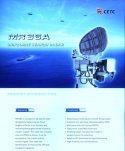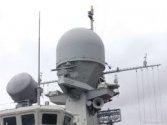You are using an out of date browser. It may not display this or other websites correctly.
You should upgrade or use an alternative browser.
You should upgrade or use an alternative browser.
Russian Military News, Reports, Data, etc.
- Thread starter tphuang
- Start date
I think I understand. So the radio horizon can propagate in an extended range because of the atmospheric ducts which can use the tropospheric dispersion method, in wikipedia there is the statement that the ideal frequency range is 2 GHz, exactly the same frequency range as the band D of the Mineral-M(Mineral-U) system.
Got it correctly?
Chinese refer it as MOTH or Microwave Over The Horizon.

On the Type 366, they also use it to detect low flying aircraft and sea skimmers over the horizon. Every 052C, 052D, and 054A is equipped with this system.
MR36A is the export name for Type 362. That is the radar used on board the Type 022 FAC. Having this capability cleanly plugs a puzzle I have on these boats.
The phenomenon works particularly well over the East and South China Seas, hence its ubiquitous use. However since the Ukrainians have long leaked the system to the US, and other potential disadvantages herewith, the Chinese Navy is already going beyond past this system, hence its absence on the Type 055, which maybe a sign for future warships.
Ship radars generally operate in the X, C, S, L bands, and in these frequency bands they only travel in a straight line, some emitted signals can interact with the atmosphere and refract, in this way the range below the horizon can be extended. The radio waves that normally propagate beyond the horizon are the HF down bands (HF, MF, LF, VLF) that go around the world reflecting off the ionosphere.
A coastal search and tracking complex such as Mineral-U that operates in passive mode from band I (X-band or SHF band) to D-band (L-band or UHF band) could use atmospheric ducts to passively search and track waves. emitted by on-board naval radars that also operate in this frequency band to detect and track their targets. Enemy radar location plays an important role in modern warfare.
For example, the AN/SPS-67(IFF antenna operates in the L-band - D-band or UHF band) and claims to have a detection range >104 km, this is the Arleigh Burke surface search radar but can also detect air targets at low altitudes and cruise missiles, it is found that the radar is at an altitude position of 30 to 40 meters on the ship, calculating the radar horizon for a radar position at 40 meters and the target also at a height than 40 meters, the horizon detection range is half the effective range of the radar which is >104 km. This means that naval radars propagate electromagnetic wave radiation through the troposphere generating "footprints" that an enemy radar could track and detect through atmospheric ducts.
I think that in the same way that a Mineral-M uses atmospheric ducts to extend the detection range, the AN/SPS-67 also does it in the same way, but its range is much smaller than the Mineral-M. In this way, a Mineral-U could passively detect the signal from enemy naval radars (L, S, C and X bands) at long distances.
View attachment 87224
As far as I'm aware, SPS-67 lacks any ducting ability. It's basically a navigation radar, and you can add the ability to detect, follow and track flying objects to any navigation radar. However you will only be limited to 2D information. It's getting replaced by the SPQ-9B on newer ships, and when ships are upgraded to Aegis Baseline.
Burke uses COBLU and SQS-32 aka SEWIP for long range OTH passive detection. COBLU uses a choke antenna on top of the spindle mast, where you can find the ship's TACAN, IFF, ESM and CEC.
That looks a lot more like a missile hit.
another picture.
That looks a lot more like a missile hit.
It does to me. I am not an expert though. I was wondering if there was one amidships and more aft.
Fires through the port holes suggest DC wasn't effective to me.
I think it's pretty likely the Ukrainians bagged a Slava.
They were not even paying attention it
They were not even paying attention it seems. Wow.
I won't be surprised if the ship is running on a skeletal crew, and many systems are non functional, potentially cannibalized already to keep other ships, like her sisters, working. The ship was by all means, a sitting duck, brought back to commission for military parade purposes.
I won't be surprised if the ship is running on a skeletal crew, and many systems are non functional, potentially cannibalized already to keep other ships, like her sisters, working. The ship was by all means, a sitting duck, brought back to commission for military parade purposes.
I have to say I seriously doubt that. Russia just deployed Moskva to the Ukrainian coast in an ongoing war. Either they are idiots for doing so with a skeleton crew and nonfuncitoning ship - the flagship, no less! - or they are idiots for not being ready that close to shore and not being alert.
Rumor has it the head of the Black Sea Fleet has been relieved of command, if not arrested.
I think PLA is watching closely since 054As, 051C and 052B all use a modernised copy of the Fregat if I'm not wrong
Don't worry about those ships. 051C and 052B both used much more modernized versions of the FREGAT with modern backend microelectronics. The Type 054A is even better because Type 382 is further evolved from FREGAT, using Chinese microelectronics, has double the scan rate. The arrays on the Type 382 is S band on one side, C-band on the other, the C-band is for surface scanning with the higher frequency being more sea clutter resistant. Should be noted that FREGAT was looking to develop a version that has S and C bands, instead of two different S bands (corresponding E and F bands on NATO). FREGAT has a single face array that's only on C-band and it's been seen fitted on some Udaloys.
In addition the Chinese ships have dedicated surface scan radars meant exclusively to detect low flying objects through the Type 364 radars. This was added to the refitted Sovremenny. The Type 364 uses C-band and is meant to cut through surface clutter and propagation. See earlier posts explaining this. PLAN caught the issue of clutter and propagation rather early, hence the development of the Type 364 and its first installation on the 052B.
Then you have the Type 366 radar, the Chinese version of the Mineral radar but is enhanced with modern microelectronics and added the ability to detect low flying aircraft over the horizon using ducting. Again see earlier posts explaining this.
Then you have the Type 347G gunnery radar which might have a narrow search mode, plus two navigation radars. You maybe able to add a low flying target detect mode on those two.
On top of all these are passive ESM systems.
Lots of overlap and redundancy there.
Russians have long been aware of the clutter and propagation issue with longer frequency air volume search radars and hence the development of the Pozitiv radar which works on the X-band and is dedicated for surface scan of low flyers.

It's installed on small littoral ships similar to the way Mineral is installed because these radars deal better with the littoral conditions with the rocks, islands, coast and sea bottom.
PLAN specifically ordered these installed on the last two Project 956EM, now numbers 138 and 139.
It's installed on the Admiral Grigorovich classes, which gives these frigates a much stronger advantage detecting and engaging a low flying antiship missile than the Moskva.

It's installed on small littoral ships similar to the way Mineral is installed because these radars deal better with the littoral conditions with the rocks, islands, coast and sea bottom.
PLAN specifically ordered these installed on the last two Project 956EM, now numbers 138 and 139.
It's installed on the Admiral Grigorovich classes, which gives these frigates a much stronger advantage detecting and engaging a low flying antiship missile than the Moskva.
I have to say I seriously doubt that. Russia just deployed Moskva to the Ukrainian coast in an ongoing war. Either they are idiots for doing so with a skeleton crew and nonfuncitoning ship - the flagship, no less! - or they are idiots for not being ready that close to shore and not being alert.
Rumor has it the head of the Black Sea Fleet has been relieved of command, if not arrested.
The answer to that is very simple.
They are idiots indeed. Incompetence and stupidity can never be underestimated.
Surprised no ones brought up in my opinion what is the most likely cause for what sank the Moskva - human error. Look at what happened to HMS Sheffield.
50 days at war in the Black Sea against an adversary with no navy and not much to do. It would be possible to get complacent and overlook ignore an incoming missile as a false alarm.
50 days at war in the Black Sea against an adversary with no navy and not much to do. It would be possible to get complacent and overlook ignore an incoming missile as a false alarm.
As he should be.Rumor has it the head of the Black Sea Fleet has been relieved of command, if not arrested.
